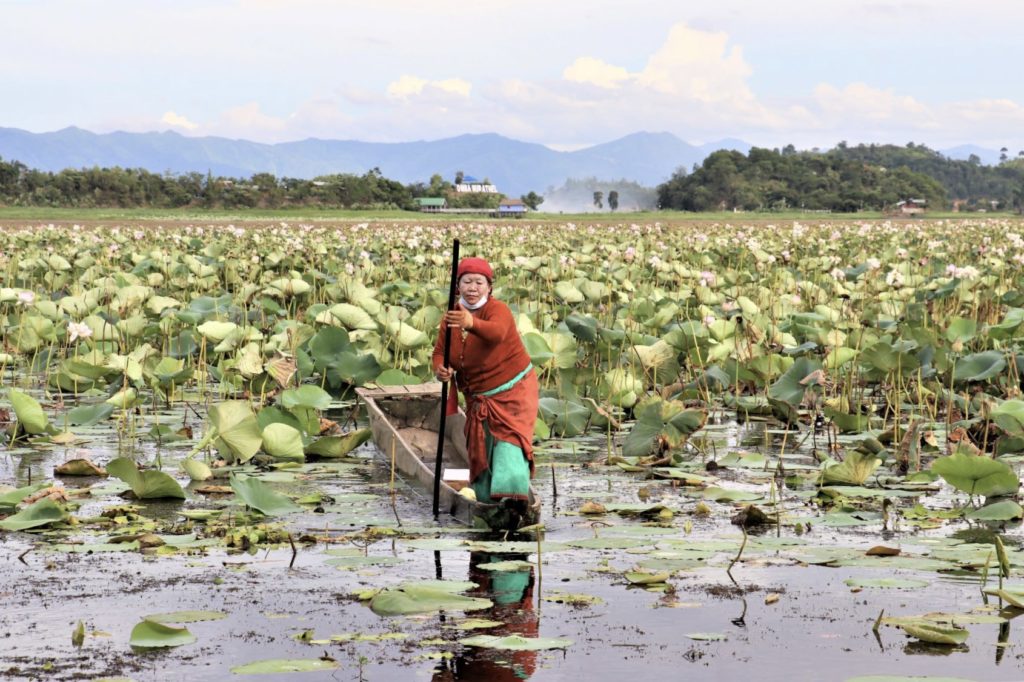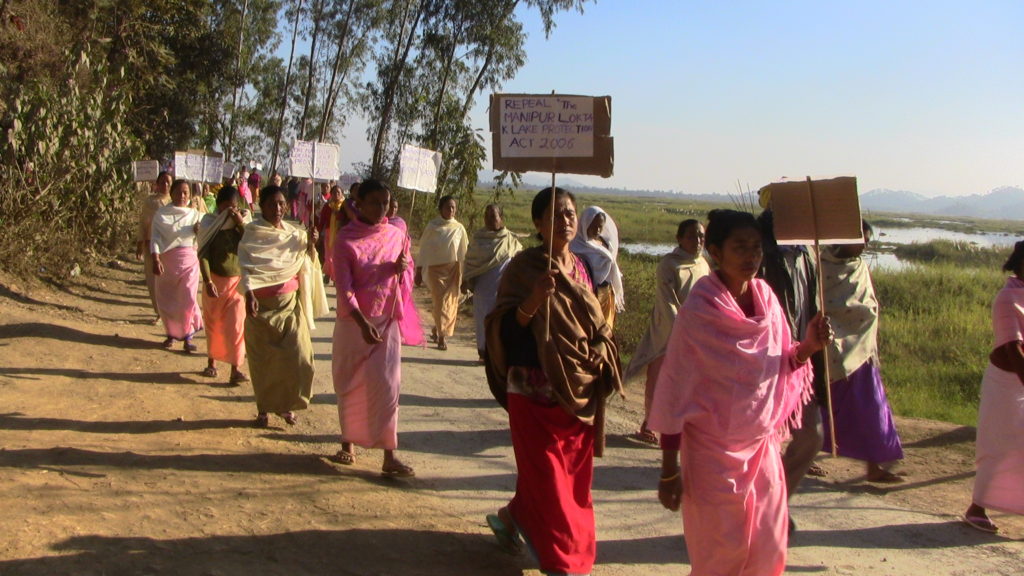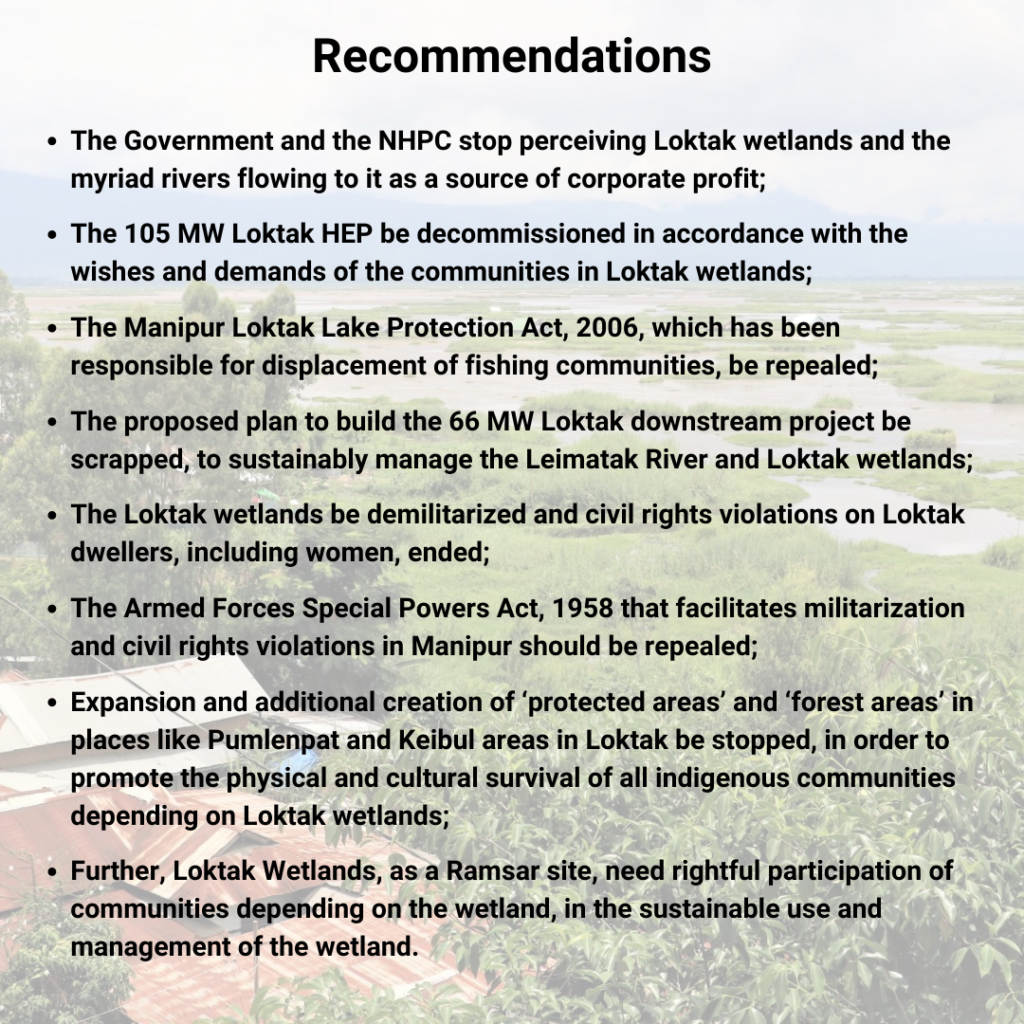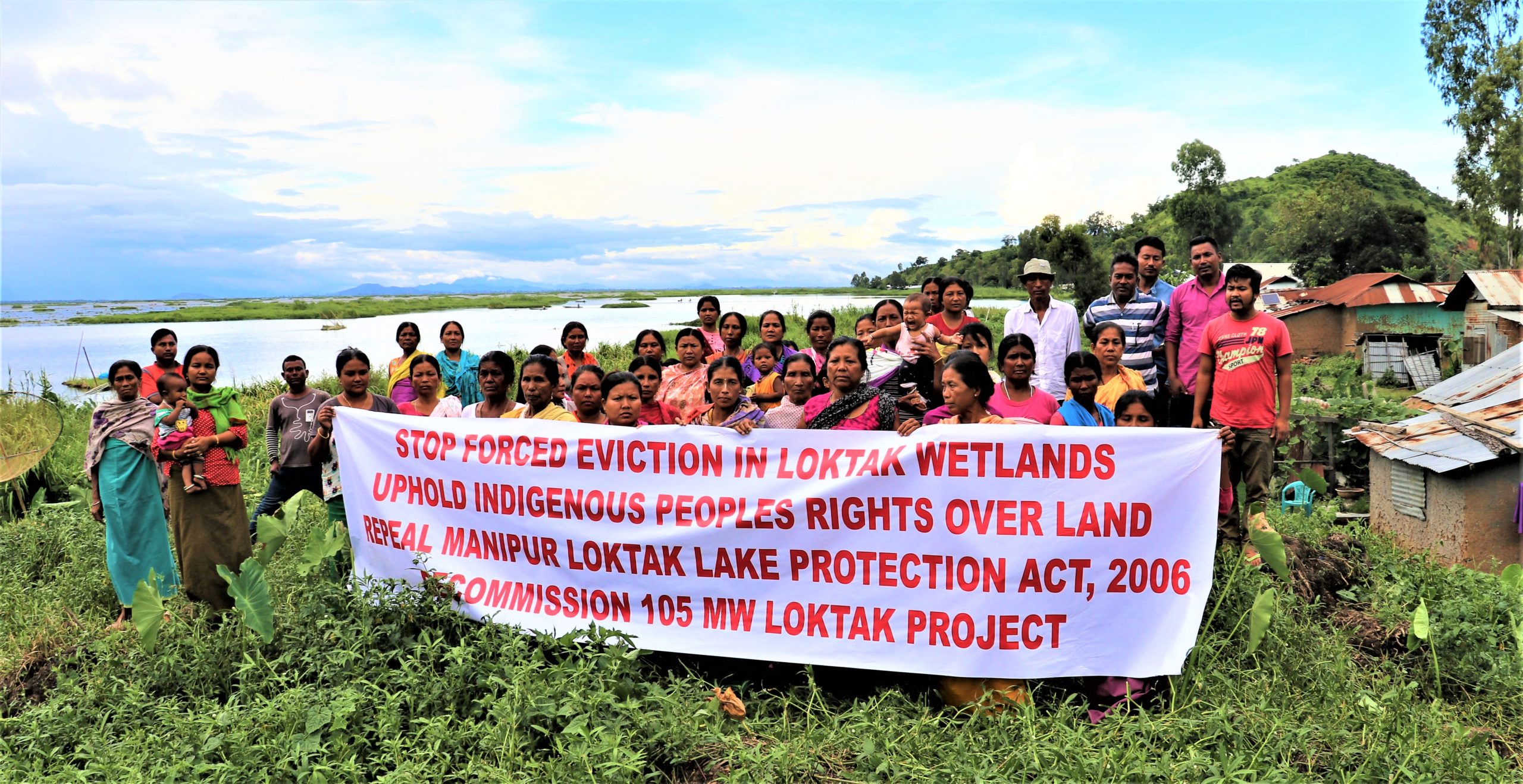By: Jiten Yumnam, Nalori Dhammei Chakma and Petro Kotze
The Meitei people call the Loktak Wetlands in India’s North East region Loktak Lairembi or, the mother goddess. The wetlands are the foundation of their socio-economic development and rich cultural heritage, but has been decimated by the construction of the contentious and controversial 105 MW Loktak Multipurpose Hydroelectric Project (Loktak HEP).
The hydroelectric project submerged the wetlands, with vast consequences for the generations of communities that intimately depend on the system for their livelihoods. Women in particular are hit hard. The loss of the Loktak Wetlands ripples into every crevice of their lives, as the Loktak HEP drowned out their cultural history, capacity to make a living and home for their families, and their right to voice their concerns.
What women lost when the Loktak Wetlands were submerged
The Loktak Wetlands, a protected Site under the Ramsar Convention, lies in the basin of the Manipur River. The ebb and flow of the river regulates the fragile ecosystem of Manipur Valley, part of the larger Chindwin-Irrawaddy River Basin of Burma. The water level of the wetlands fluctuates according to season, regulating a diverse array of aquatic flora and fauna. It is part of the Indo-Burma Biodiversity Hotspot.
The wetlands allow for the migration of fish from the Irrawaddy River System and the growth of the wetlands’ famous phumdi, floating biomass composed of soil, plants and organic matter. The wetland absorbs floodwater during monsoon and its water is used for agriculture during dry seasons. For generations, the people of Manipur, the Meitei, Nagas and Kukis, lived in close proximity to the oscillating flow of the wetlands.

They build their traditional floating huts (phumshang) on the phumdi to live in and to fish from and for generations, the Meitei in particular, have taken care of the wetlands and surrounding forests and hills, without possessing formal land titles over their fields. Women fulfil multiple roles integral to the sustainable management of Loktak wetlands. Each season, they trim and dispose of excess phumdi and help to build the phumshang. They also collect reeds from the surrounding forested areas of Keibul Lamjao for firewood, to smoke fish and for building material.
Women are also the bearers of local cultural heritage practices, and much of the socio-economic functioning of the communities. They are involved in the making of the traditional fishing gear from reeds, bamboo, cane and cotton and they weave traditional clothing like phanek and khudei’. In Manipur, it is the women who manage the local traditional markets, where they trade fish and seasonal plants harvested from the wetlands.
Over and above their social and economic proximity to the wetlands, Loktak is the cultural heartland of the Meitei people of Manipur. According to Meitei folklore, Loktak is home to the revered mythical horned python called Poubi Lai, one of many folktales centered around the wetlands, narrated and performed by women during rituals and ancestral ceremonies.
But this sensitive and rich system collapsed when the wetlands were submerged and converted to a reservoir for the Loktak HEP and irrigation facilities. The Ithai Barrage, constructed in 1979 on the confluence of the Manipur and the Khuga rivers, now maintains the water level of the Loktak Wetlands at a constant 668 meters. The water stored in the wetland is now channelled to Leimatak Power Station through the Ningthoukhong canal for power generation.
Local communities were dealt a further blow when the Manipur Loktak Lake Protection Act (LPA) was promulgated in 2006. The LPA is enforced by the Loktak Development Authority (LDA) to ensure an uninterrupted water flow for the Leimatak Power Station under the pretext of protecting the wetlands. The law divided the wetlands into zones that prohibits various activities, including fishing and waste disposal, that undermines the community’s human rights.
The development has been a death knell to the socio-economic life and environmental integrity of the Manipur Valley.
The Impact of the Ithai Barrage on the Loktak Wetlands and its people
The Loktak HEP caused massive displacement of the Meitei people of Manipur. Many families were banished with no compensation, resettlement or rehabilitation plan in place. The communities had no choice. In November 2011, nearly 700 phumshang were burnt down by the government, affecting more than 3,000 people, and many women from Langol Shabi and Nambul Machin areas. The LDA contended that the communities who had been managing the wetlands for generations, were now encroaching on the wetlands.
“Many were displaced due to the Loktak Protection Act,” says Ms. Heisnam Chaoba of Thanga Heisnam. “Many moved out of the villages and they are now staying in tents at Imphal City and other places in search of work. Many are now engaged in construction works, driving auto-rickshaws or pulling carts etc. The Government failed to compensate the affected fisherfolks for torching their floating huts in 2011 and 2012.”
However, even for those that were allowed to stay, the prospects are bleak. An estimated 83,450 hectares of agricultural lands on both sides of Ithai Dam has been affected. Paddy fields which have been in existence for hundreds of years, sustaining families for generations, have been submerged, directly affecting more than 100,000 individuals, mainly of the Meitei community.
The barrage also formed a barrier to migrating fish, decimating numbers and, in turn, the livelihoods of the fishermen that depend on them. Several indigenous species, including Ngaton, Khabak, Pengba, Tharaak, Ngaaraa and Ngaatin have disappeared.
“Fishing, drying, smoking and marketing of fish are women’s work,” says Ms. Ahanthem Memthoi (65) from Sendra. She remembers catching a variety of fish from Loktak, like Pengba, Tharak, Ngara, Sareng, Sareng Khoibi and Ngaton. “We no longer catch these fishes.”
Since the water level of the wetlands are not allowed to fluctuate any more, countless fauna and flora species have been affected. One is the Sangai, the endangered brown antlered deer. Found only in Manipur, the deer’s natural habitat is close to disappearing. The floating phumdis are also unable to recede and be nourished with soil and organic materials again, while the various indigenous aquatic edible plants like heikak (water chestnut), thaangjing, tharo, thambaal, loklei, pulei, yelang, kengoi and koukha have decreased, since their roots cannot extend to the bottom soil of the wetland anymore. Some indigenous rice varieties have already been lost, including Moirangphou, Phourel and Waiyu Chara (wild rice).
Once self-sufficient, Manipur now imports food.
The impact on the lives of local communities and women in Loktak and the surrounding areas have been severe. Women cannot fish or collect edible plants, or trade their goods at the market, anymore. They are also not able to keep their cows and buffaloes, since this land is now submerged.
“Earlier, even people without formal education and unemployed people could easily sustain livelihood by fishing in Loktak wetlands,” Ms. Heisnam Chaoba, a Meitei of Langolshabi Village, says. However, fish catches declined and heikak, a major food source that was widely available before, has nearly disappeared, she says.
Ms. Heisnam Leinungshi, of Thanga Salam says: “Traditional rice species like the taothabi, moirang phou, and waiyu jara were abundant before. Waiyu jara, a traditional wild rice was widely available in the wetland but is now extinct due to the Loktak HEP.” She says the wild rice provided food for several months, and was offered to their ancestral deities to bless the community, and they could sell the water chestnut as additional income for their families, as many people from outside of Lotak came to collect the produce.
The direct and indirect impacts of the Loktak HEP have rippled into all aspects of women’s lives, and those of their children and future generations. Women have been forced to borrow money, pushing them into debt. Families are unable to support their children or pay for their education.
“The Ithai Dam is destroying our livelihood,” says Heisnam Ashangbi, of the local Thanga village. “The Government is destroying our children’s future.”
Once independent and proud fishermen have been forced to work as unskilled labourers, leaving their homes and communities in search of jobs. Many phumshang were razed and athaphum for fishing removed by force. This happened to Ms. Premila (67) from the Thanga Heisnam Leikai village. “Fishing was all our family is good at and for many years it was enough to make ends meet. I would join my husband in fishing and sell fishes at Ningthoukhong Bazar. The Loktak HEP deprived us of our only means of earning income. Now, I am forced to take up a very different life at a rented place at Imphal town for nearly eight years with my two children.”
“The Government should kill us all rather than harassing us like this,” says Ms. Pramo of Langolshabi. “It is better for us to die, rather than torturing us”.
The impact of the Ithai Barrage and the Loktak HEP goes far beyond the Loktak Wetlands. Ms. Indubala is from of Chairel, a Meitei village located downstream if the Ithai Barrage, that was famous for traditional earthen pottery works. “Women are the ones involved in making traditional pottery,” she says, “but with the Ithai Barrage and the sudden release of water from the barrage, the deposition of sediments in the repeated flooding has covered the area where villagers collect the earth suitable for pottery.” Now, it is very difficult for villagers to find the clay, and they cannot afford expensive machinery to help them. “The Loktak project has affected the traditional practice of pottery making with hand and the livelihood of women” she says. Many women were forced to abandon pottery and the associated traditional knowledge.
Chairel is not the only village to suffer from floods due to releases from Ithai Barrage. In 2017, there were at least five floods, in which 25 people were killed. The floods are mostly attributed to the National Hydroelectric Power Corporation (NHPC) refusing to open gates of Ithai Barrage. The Nongmaikhong areas and other villages close to the Ithai Barrage suffered the most damages.
“We experienced the worst flood ever in the past decade as flood water entered our fish farms three times in a row in 2017. Our village gets flooded frequently due to the Ithai Barrage,” says Ms. N. Bidyarani (47) of Nongmaikhong Awang Leikai, Bishenpur district.
It has happened before. In 2002, extensive damage was inflicted by flooding, costing seven lives and affecting more than 40,000 hectares of agricultural land, amounting to losses of around Rs 600 crores.
The plight of the people of the Loktak Wetlands have been unimaginably heavy. The NHPC still refuses any compensation for losses, saying that the villagers do not have property titles to make claim on any. Except for the losses they have already suffered, women have been the victims of the extensive militarization of the area to protect the power station and related infrastructure. Thousands of villagers from the Loktak areas have fled and sought asylum in makeshift relief camps at Ithai Khunjao, Laphupat and Tera Khunou.
Their suffering is unlikely to end soon. In 2018, the NHPC received approval to extend the life of the Loktak HEP by another 25 years. The NHPC is preparing to construct the 66 MW Loktak Downstream Hydroelectric Project by utilizing the water discharge from the Loktak power Station and the natural flow of the Leimatak River.
A course of action for advocacy

For the Meitei communities, Loktak Wetlands is life, a sacred source of their folksong, folklores and cultures. Loktak sustained lives for generations. Manipur’s unique identity and integrity will be rendered meaningless with the complete loss of the wetlands. The recognition of the intrinsic role of communities and incorporation of their indigenous knowledge and cultural practices, including the role of women, is crucial in sustainable management of the wetlands in future.
Despite vehement resistance, the project authority, NHPC and government refuses to either decommission the Ithai Barrage or to repeal the Manipur Loktak Lake Project Act, 2006.
As such, the Loktak HEP has become a symbol of the plunder of the land and resources of Manipur and the thwarting of women’s roles in fostering food sovereignty. Communities in Loktak continue to advocate against the continued efforts by the State to undermine community rights over Loktak wetlands through additional policies.
How can we live dignified lives, asks Ms. Heisnam Ashangbi. with the inhumane, merciless harassment of the Government? “We are prepared to sacrifice our lives to defend our rights,” she says.

International Rivers’ South Asia program is part of the regional Transboundary Rivers of South Asia program. Supported by the Government of Sweden, TROSA is a collaboration with Oxfam, IUCN, ICIMOD and many local organizations that works on some of the more complex rivers in South and Southeast Asia: the Ganga, Brahmaputra and Meghna river systems, including their tributaries such as the Teesta, and Asia’s last last free flowing river, the Salween. The program aims to contribute to poverty reduction and marginalization among vulnerable river basin communities through increased access to and control over riverine water resources on which their livelihoods depend.

